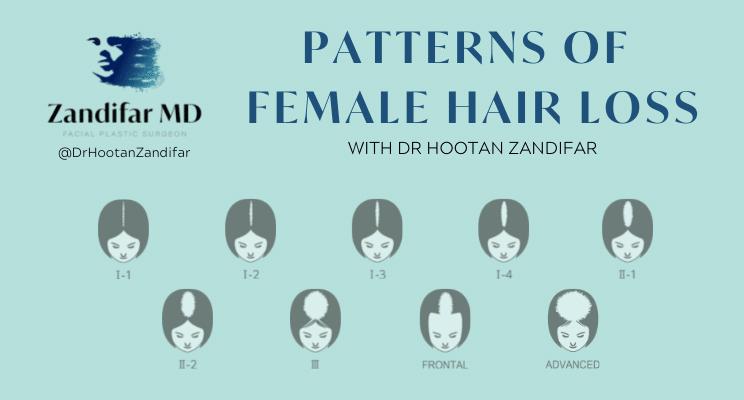I am a woman and feel like I am losing my hair. Is this possible?
The short answer is yes. Although male pattern baldness is really the most common type of hair loss that is seen, about 1 in 5 women have experienced hair loss or baldness that they would consider medical or surgical treatment. The most common complaint that women suffer from is thinning of their hair. This is usually pronounced in the forehead region. However, occasionally women can present with sporadic bald spots on their scalps.
Presentation of Female pattern hair loss.
This is mostly because females generally have longer hairstyles and thus lots of early signs can be masked. Here are some signs that you may be suffering from female pattern baldness.
- You notice that the part in your hair is widening.
- You notice more hair is falling during the shower, brushing, etc… (On a daily basis we usually lose 100-150 hairs).
- You are losing volume in your hair (After menopause some volume loss in normal due to hormonal changes).
- You start to notice more of your scalp (In people with long hair this could be a late sign).
- Frontal hairline starts to recede and more of the forehead is shown (This is not a typical presentation but can happen in some individuals).
……………………
Patterns of female hair loss (Ludwig Scale)
It is important to first and foremost find the cause of hair loss in women. After finding the underlying cause is reversible then we can explore medical treatment options for your hair loss. If it is not reversible then the following staging system helps in determining the available treatments.
- I-1 This stage is the earliest stage of hair loss in women. It is defined by thinning along the hairline. Medication and PRP treatment is usually the best solution. A small amount of hair transplantation can be performed but is not the first treatment option.
- I-2 The thinning along the hairline is slightly worse than the previous stage. Treatment continues to center around medication and PRP injections. Hair transplantation can be utilized but is not usually necessary.
- I-3 The thinning along the top of the scalp is now more noticeable with a wider hair part centrally. Medications and PRP treatment can slow down or stop further loss while proper diagnosis of the cause is necessary. Hair transplantation can be used to fill in the defect.
- I-4 At this stage the hair loss leads to the beginning of an un-natural appearance of the hair part and the top of the scalp. The defect can still be camouflaged and treated with medication and PRP treatment but hair transplantation is the best option for covering the defect.
- II-1 There is increased central balding of the hairline with thinning of the surrounding area. While medication and PRP treatment can prevent further loss, hair transplantation is the best option at this stage.
- II-2 Central balding continues to worsen. There is a significant amount of scalp that can be seen through the hair. Hair transplantation is the best option going.
- III Significant balding or thinning is noted. There may even be a large bald spot on the top of the head. Hair transplantation is usually the only option.
Advanced This stage is the progression of stage III with an increased bald spot. Depending on the amount of hair loss, transplantation can be a great option. However, if the bald spot is significantly large then treatment may center around the use of hairpieces.
Frontal This is marked by frontal and temporal hair recession with some thinning along the hairline. Hair transplantation can very nicely re-create a natural feminine hairline.
What are some treatment options for female pattern baldness?
Femail hair loss can happen for a variety of different reasons. It’s the cause of the hair loss that will help us determine the best course of treatment and it’s also important to keep in mind that not all treatment options are appropriate for all causes of hair loss.
- Minoxidil – Minoxidil is a medication for hair loss that stimulates growth in the hairs and may increase their growth cycle.
- Ketoconazole – This drug has been shown effective to help treat hair loss in androgenetic alopecia, where inflammation of hair follicles contributes to hair loss.
- Corticosteroids – Some women suffering from hair loss may respond to corticosteroid injections. This treatment is only used when necessary for conditions such as alopecia areata.
- Hormone Therapy – In some situations, conditions such as menopause can lead to a hormone imbalance and hair loss. In those situations, hormone therapy can be used to prevent or stop hair loss.
- Hair Transplant Surgery – In cases where the patient does not respond well to medical treatments or the cause of the hair loss can not be treated with medication hair transplant surgery may be the best way to help a woman restore her hairline.
What is the best hair restoration treatment for me?
Ask your doctor. The best way to determine your best course of action is to talk to your doctor. If it turns out that you need a surgical hair transplant book a consultation now with Dr. Hootan Zandifar. Dr. Zandifar can talk you through the procedure and explain how hair transplantation can restore your hair and reduce future hair loss.


